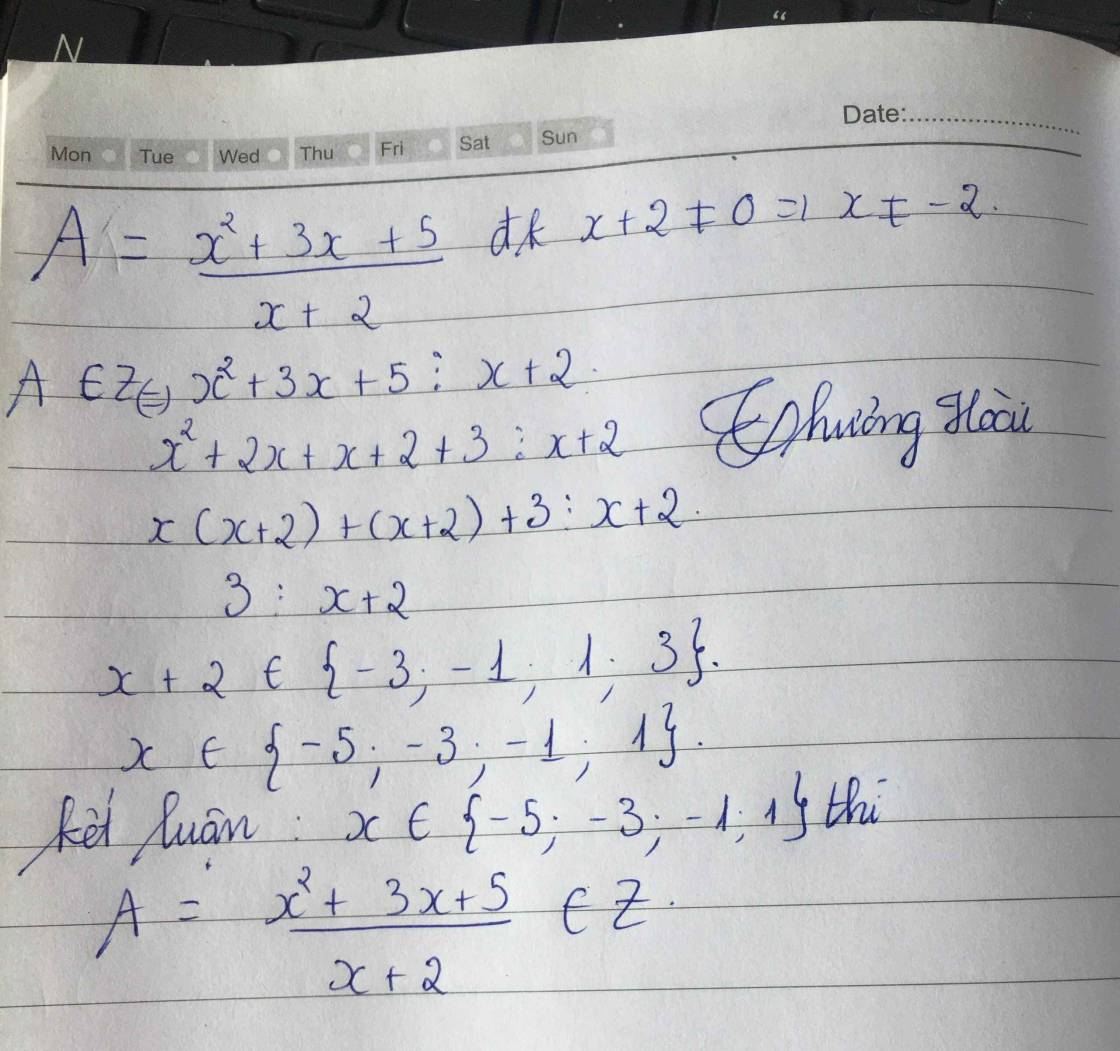3x+5/x-2 thuộc Z
Hãy nhập câu hỏi của bạn vào đây, nếu là tài khoản VIP, bạn sẽ được ưu tiên trả lời.



b) A=\(\frac{5x-2}{x-3}=\frac{5x-15+13}{x-3}=\frac{5x-15}{x-3}+\frac{13}{x-3}=\frac{5\left(x-3\right)}{x-3}+\frac{13}{x-3}=5+\frac{13}{x-3}\)
Để A thuộc Z thì \(5+\frac{13}{x-3}\in Z\)
=>13 chia hết cho x-3
=>x-3 \(\in\)Ư(13)={-1;1;-13;13}
x-3=-1 x-3=1 x-3 =-13 x-3=13
x =-1+3 x =1+3 x =-13+3 x =13+3
x=2 x =4 x=-10 x=16
Vậy x=2;4;-10;16 thì A thuộc Z
c)B=\(\frac{6x-1}{3x+2}=\frac{6x+4-5}{3x+2}=\frac{6x+4}{3x+2}+\frac{-5}{3x+2}=\frac{2\left(3x+2\right)}{3x+2}+\frac{-5}{3x+2}=2+\frac{-5}{3x+2}\)
Để B thuộc Z thì \(2+\frac{-5}{3x+2}\in Z\)
=>-5 chia hết cho 3x+2
=>3x+2\(\in\)Ư(-5)={-1;1;-5;5}
3x+2=-1 3x+2=1 3x+2=-5 3x+2=5
3x =-3 3x =-1 3x =-7 3x =3
x =-1 x =-1/3 x =-7/3 x =1
Vậy x=-1;-1/3;-7/3;1 thì B thuộc Z
d) C=\(\frac{10x}{5x-2}=\frac{10x-4+4}{5x-2}=\frac{10-4}{5x-2}+\frac{4}{5x-2}=\frac{2\left(5x-2\right)}{5x-2}+\frac{4}{5x-2}=2+\frac{4}{5x-2}\)
Để C thuộc Z thì \(2+\frac{4}{5x-2}\in Z\)
=> 4 chia hết cho 5x-2
=>5x-2\(\in\)Ư(4)={-1;1;-2;2;-4;4}
5x-2=-1 5x-2=1 5x-2=2 5x-2=-2 5x-2=4 5x-2=-4
bạn tự giải tìm x như các bài trên nhé
d) bạn ghi đề mjk ko hjeu
e)E=\(\frac{4x+5}{x-3}=\frac{4x-12+17}{x-3}=\frac{4x-12}{x-3}+\frac{17}{x-3}=\frac{4\left(x-3\right)}{x-3}+\frac{17}{x-3}=4+\frac{17}{x-3}\)
Để E thuộc Z thì\(4+\frac{17}{x-3}\in Z\)
=>17 chia hết cho x-3
=>x-3 \(\in\)Ư(17)={1;-1;17;-17}
x-3=1 x-3=-1 x-3=17 x-3=-17
bạn tự giải tìm x nhé
điều cuối cùng cho mjk ****


Mk làm mẫu các phần khác tương tự nhé !
\(F=\frac{-11}{x+1}\)hay \(x+1\inƯ\left(-11\right)=\left\{\pm1;\pm11\right\}\)
| x + 1 | 1 | -1 | 11 | -11 |
| x | 0 | -2 | 10 | -12 |

ĐKXĐ: \(x\ne\pm3\)
a
Khi x = 1:
\(A=\dfrac{3.1+2}{1-3}=\dfrac{5}{-2}=-2,5\)
Khi x = 2:
\(A=\dfrac{3.2+2}{2-3}=-8\)
Khi x = \(\dfrac{5}{2}:\)
\(A=\dfrac{3.2,5+2}{2,5-3}=\dfrac{9,5}{-0,5}=-19\)
b
Để A nguyên => \(\dfrac{3x+2}{x-3}\) nguyên
\(\Leftrightarrow3x+2⋮\left(x-3\right)\\3\left(x-3\right)+11⋮\left(x-3\right) \)
Vì \(3\left(x-3\right)⋮\left(x-3\right)\) nên \(11⋮\left(x-3\right)\)
\(\Rightarrow\left(x-3\right)\inƯ\left(11\right)=\left\{\pm1;\pm11\right\}\\ \Rightarrow x\left\{4;2;-8;14\right\}\)
c
Để B nguyên => \(\dfrac{x^2+3x-7}{x+3}\) nguyên
\(\Rightarrow x\left(x+3\right)-7⋮\left(x+3\right)\)
\(\Rightarrow-7⋮\left(x+3\right)\\ \Rightarrow x+3\inƯ\left\{\pm1;\pm7\right\}\)
\(\Rightarrow x=\left\{-4;-11;-2;4\right\}\)
d
\(\left\{{}\begin{matrix}A.nguyên.\Leftrightarrow x=\left\{-8;2;4;14\right\}\\B.nguyên\Leftrightarrow x=\left\{-11;-4;-2;4\right\}\end{matrix}\right.\)
=> Để A, B cùng là số nguyên thì x = 4.

Ta có: \(\frac{x^2-3x+5}{x-3}=\frac{x.\left(x-3\right)+5}{x-3}=\frac{x.\left(x-3\right)}{x-3}+\frac{5}{x-3}=x+\frac{5}{x-3}\)
Vì \(x\in Z\)nên để \(\frac{x^2-3x+5}{x-3}\in Z\)thì \(\frac{5}{x-3}\in Z\)
\(\Rightarrow5⋮x-3\) \(\Rightarrow x-3\inƯ\left(5\right)=\left\{-1;1;-5;5\right\}\)
Do đó:
| x-3 | -1 | 1 | -5 | 5 |
| x | 2 | 4 | -2 | 8 |
Vậy với \(x\in\left\{-2;2;4;8\right\}\)thì\(\frac{x^2-3x+5}{x-3}\in Z\)

\(a,A=\frac{x-4}{x+1}=\frac{(x+1)-1-4}{x+1}=1-\frac{5}{x+1}\)
Để \(x\in Z\)thì \(x+1\inƯ(5)\)
mà \(Ư(5)=(5;1;-1;-5)\)
Ta có bảng sau
| x + 1 | 5 | 1 | -1 | -5 |
| x | 4 | 0 | -2 | -6 |
Vậy \(x=(4;0;-2;-6)\)
\(b,B=\frac{3x-5}{x-2}=\frac{3x-6+1}{x-2}=\frac{3x-6}{x-2}+\frac{1}{x-2}=\frac{3(x-2)}{x-2}+\frac{1}{x-2}=3+\frac{1}{x-2}\)
Để \(x\in Z\)thì \(x-2\inƯ(1)\)
mà \(Ư(1)=(1;-1)\)
Với \(x-2=1\Rightarrow x=3\)
Với \(x-1=-1\Rightarrow x=0\)
Vậy \(x=(3;0)\)
Chúc bạn học tốt nhé
\(A=\frac{x-4}{x+1}=\frac{x+1-5}{x+1}=\frac{-5}{x+1}\)
\(\Rightarrow x+1\inƯ\left(5\right)=\left\{\pm1;\pm5\right\}\)
Ta lập bảng :
| x + 1 | 1 | -1 | 5 | -5 |
| x | 0 | -2 | 4 | -6 |
Vì \(x\inℤ\)thì x ta tìm đc tm
\(B=\frac{3x+5}{x-2}=\frac{3\left(x-2\right)+11}{x-2}=\frac{11}{x-2}\)
\(\Rightarrow x-2\inƯ\left(11\right)=\left\{\pm1;\pm11\right\}\)
Ta lập bảng :
| x - 2 | 1 | -1 | 11 | -11 |
| x | 3 | 1 | 13 | -9 |
Vì x\(\inℤ\)nên x ta tìm đc tm

a: \(A=\dfrac{2x+1}{\left(x-1\right)\left(x-2\right)}+\dfrac{x+1}{x-1}-\dfrac{x^2+5}{\left(x-1\right)\left(x-2\right)}+\dfrac{x^2+x}{x-1}\)
\(=\dfrac{2x+1-x^2-5}{\left(x-1\right)\left(x-2\right)}+\dfrac{x+1+x^2+x}{x-1}\)
\(=\dfrac{-x^2+2x-4+\left(x^2+2x+1\right)\left(x-2\right)}{\left(x-1\right)\left(x-2\right)}\)
\(=\dfrac{-x^2+2x-4+x^3-2x^2+2x^2-4x+x-2}{\left(x-1\right)\left(x-2\right)}\)
\(=\dfrac{x^3-x^2-x-6}{\left(x-1\right)\left(x-2\right)}\)
b: Để A là số nguyên thì \(x^3-3x^2+2x+2x^2-6x+4+3x-10⋮\left(x-1\right)\left(x-2\right)\)
=>\(3x-10⋮x^2-3x+2\)
Xin lỗi bạn, đến đây mình thua rồi

\(\dfrac{3x+5}{x-2}\) ϵ Z, đk x # 2
⇔ 3 + \(\dfrac{11}{x-2}\) ϵ Z
⇔ \(\dfrac{11}{x-2}\) ϵ Z
x - 2 ϵ Ư(11) = { -11; -1; 1; 11}
x ϵ {-9; 1; 3; 13}
\(\dfrac{3x+5}{x-2}\in Z\)
\(\Leftrightarrow\dfrac{3x-6+11}{x-2}\in Z\)
\(\Leftrightarrow\dfrac{3\left(x-2\right)+11}{x-2}\in Z\)
\(\Leftrightarrow\dfrac{3\left(x-2\right)}{x-2}+\dfrac{11}{x-2}\in Z\)
\(\Leftrightarrow3+\dfrac{11}{x-2}\in Z\)
Vì 3 thuộc Z nên \(\dfrac{11}{x-2}\)phải thuộc Z
\(\Rightarrow\dfrac{11}{x-2}\in Z\)
\(\Leftrightarrow11⋮x-2\)
\(\Rightarrow\) x - 2 là ước của 11
\(\Rightarrow x-2\in\left\{-11;-1;1;11\right\}\)
Ta có bảng sau:
\(\begin{matrix}x-2&-11&-1&1&11\\x&-9&1&3&13\end{matrix}\)
Vậy: \(x\in\left\{-9;1;3;13\right\}\)